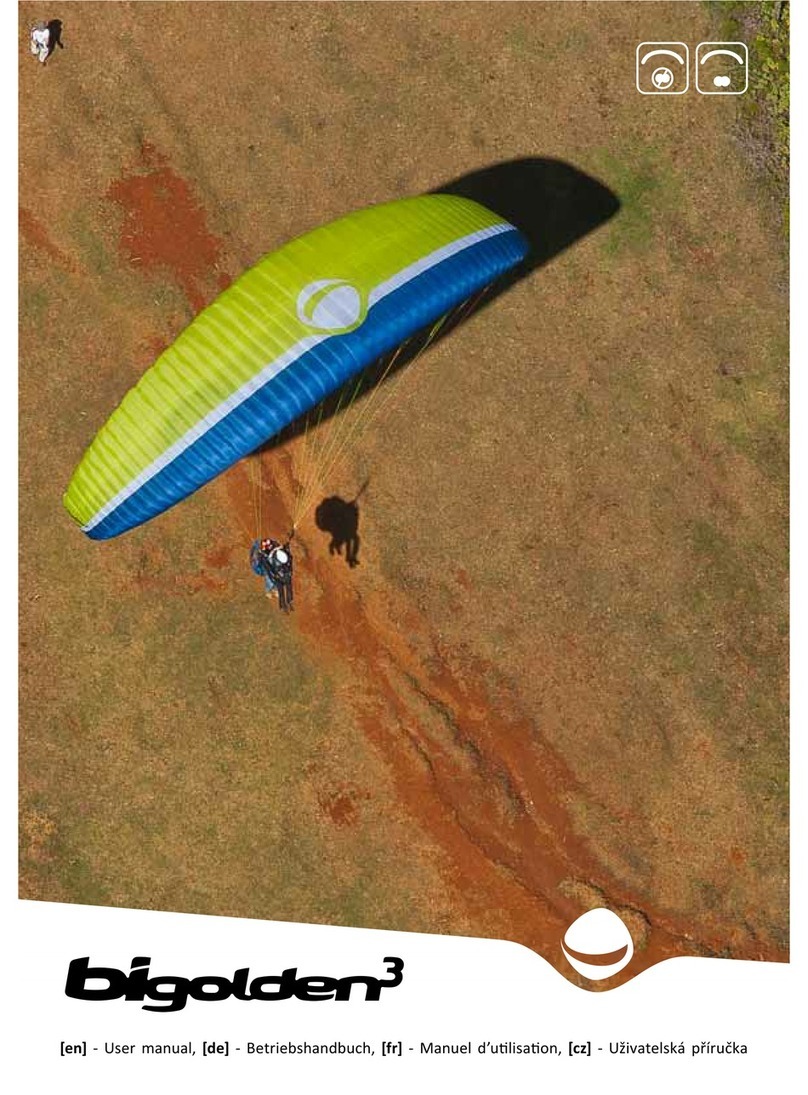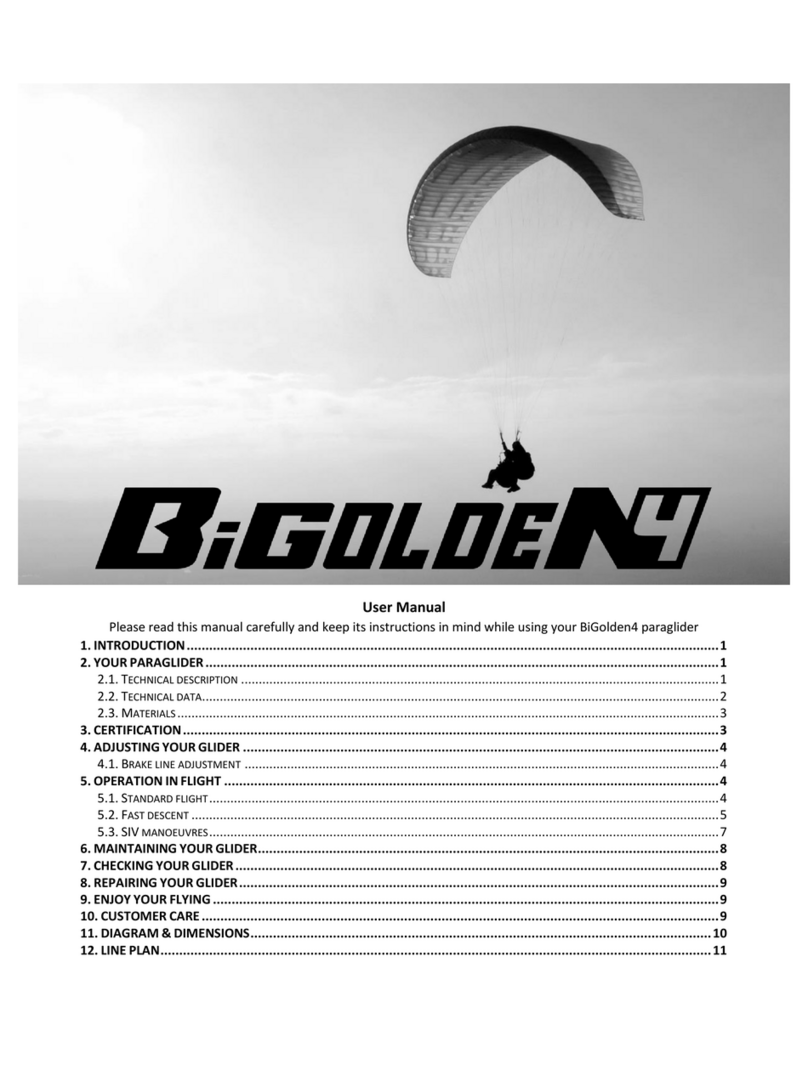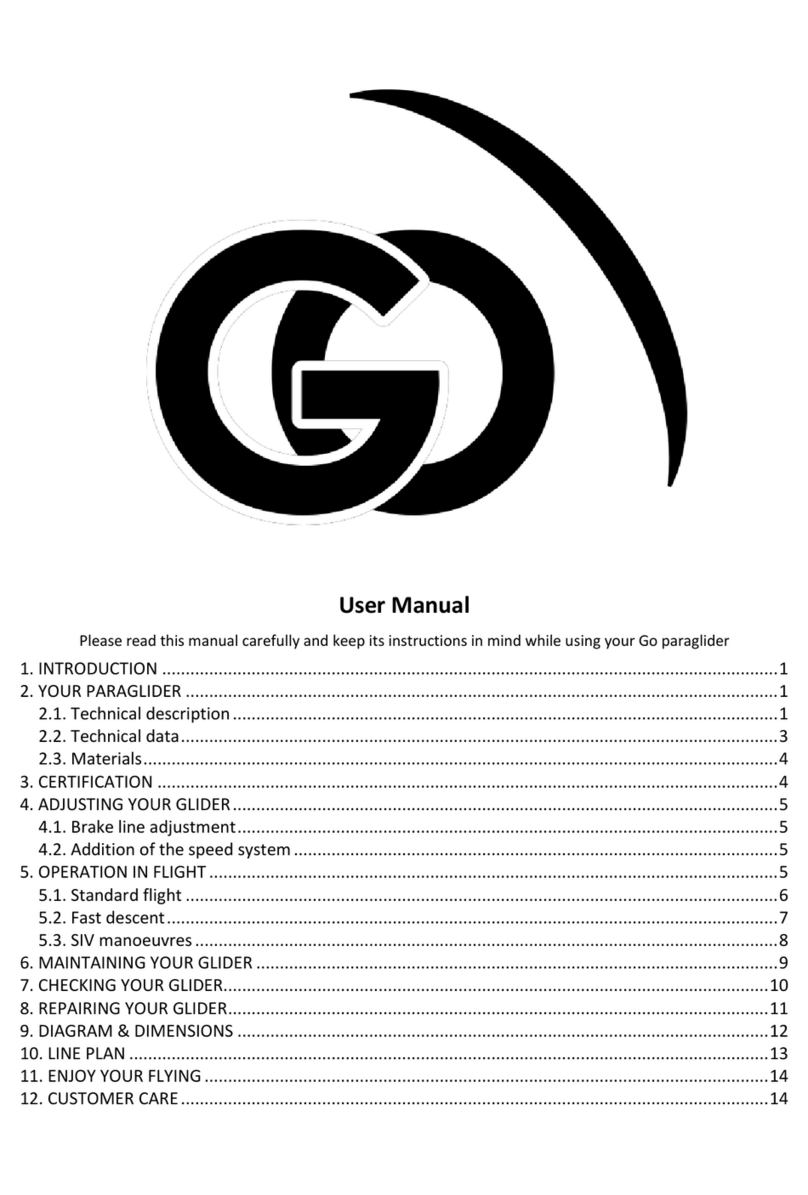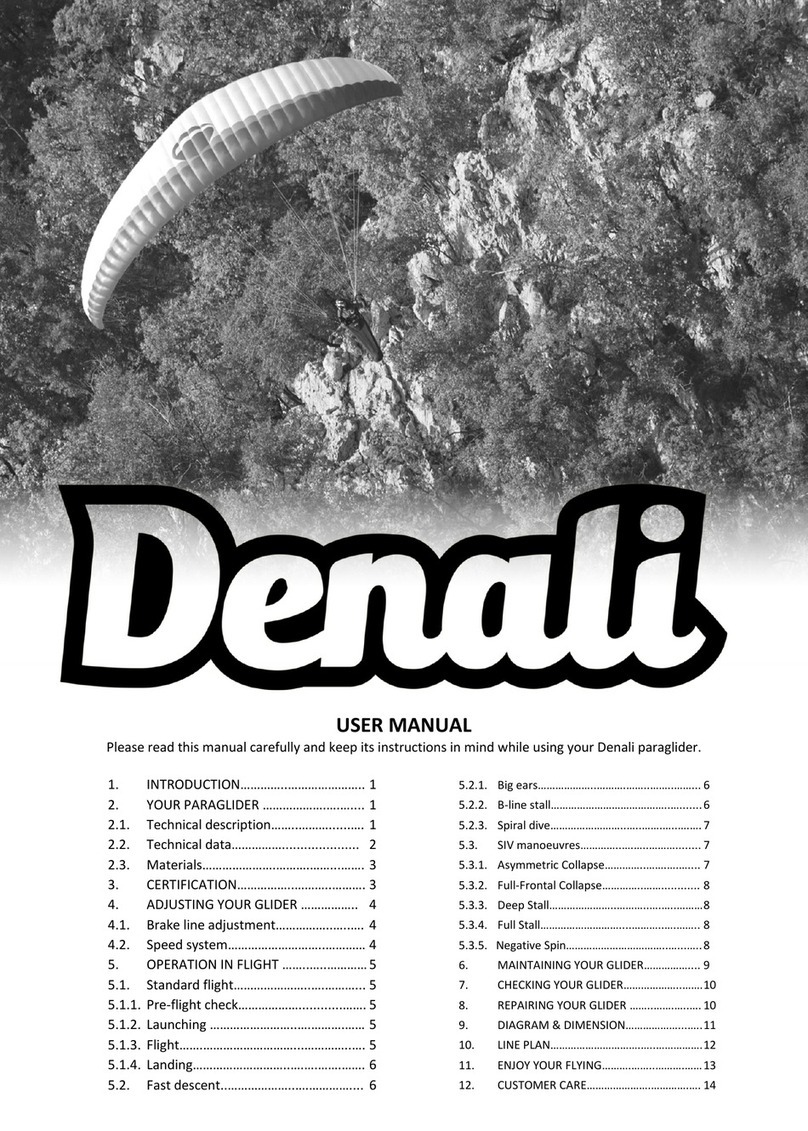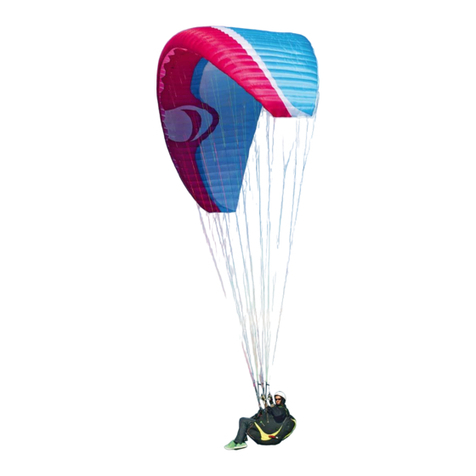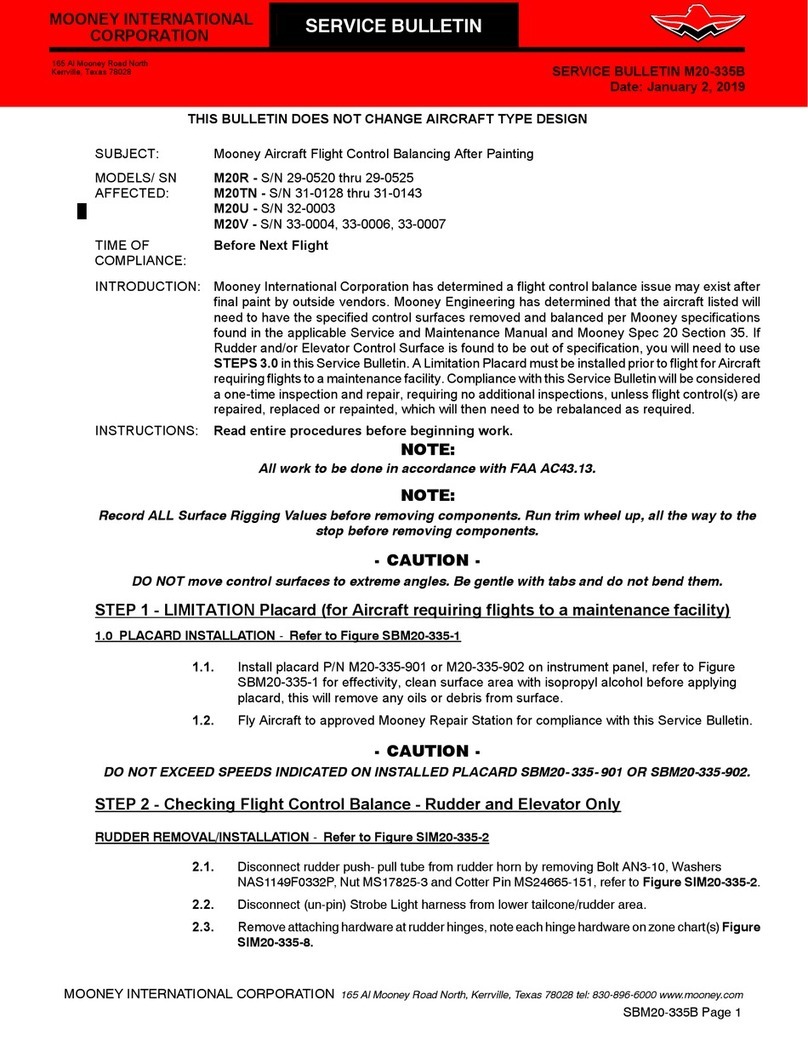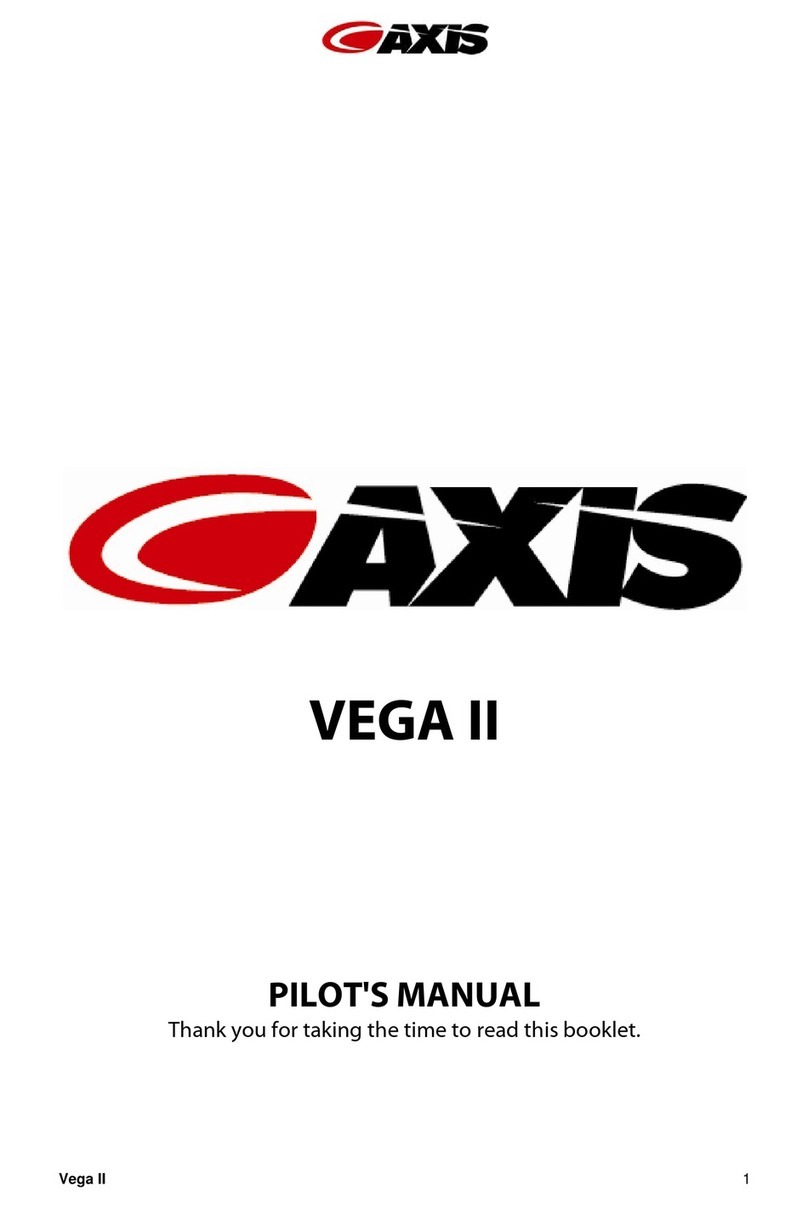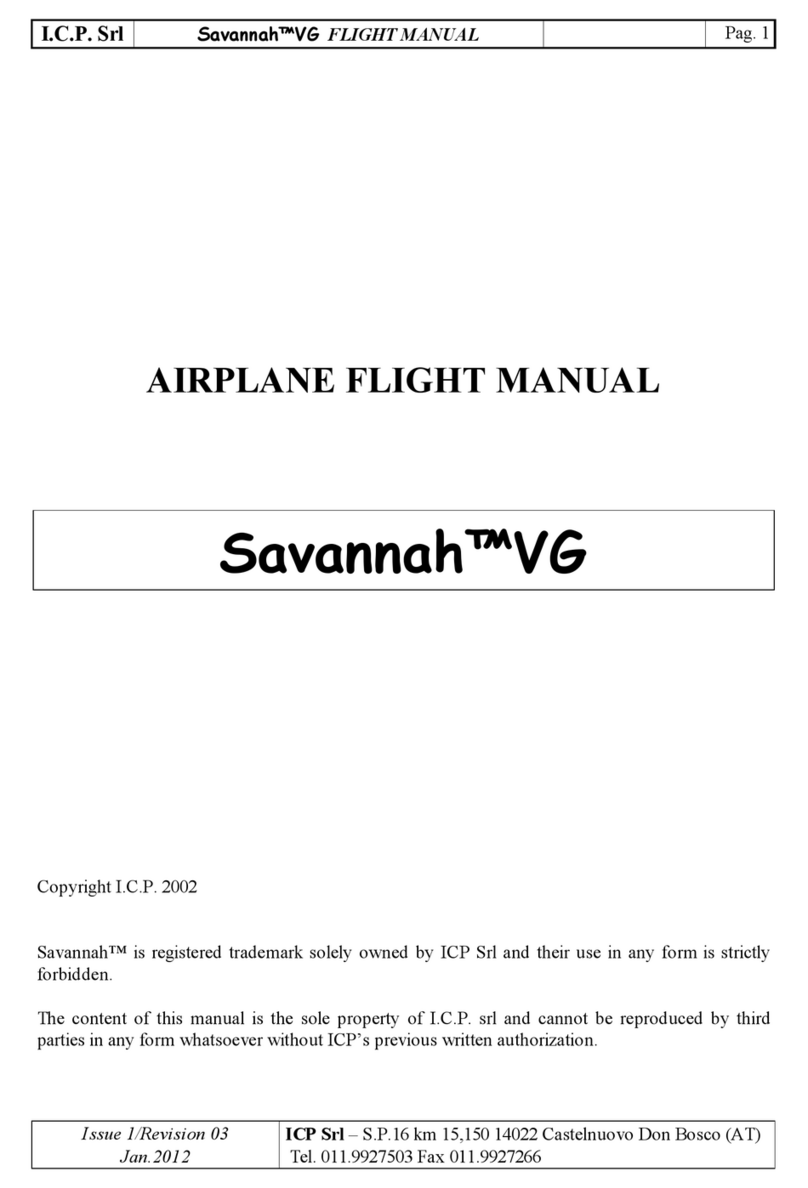Gradient GRP1 Installation and operation manual

Gradient rescue parachute
User manual Manuel ď utilisationBetriebshandbuch
[en] [de] [fr]

1
Gradient GRP1 is a life saving system for paragliding.
GRP1 is a hand-thrown or manually activated emergency para-
chute canopy. The design, materials and technologies used in
the GRP1 make the product very reliable. Panels are cut by a
CNC cutter to ensure pre-assembly precision and the right shape
of panels. The canopy is made of cloth specifically engineered for
this application. The cloth is coated with a material that prevents
sticking to facilitate smooth and rapid deployment. The cloth is
also engineered to minimise shape distortion. These features,
as well as the distinctive canopy design and the low permeabil-
ity of the cloth result in a low sink rate. The lines leading from
the canopy are selected for their superior strength and resil-
iency. They reduce opening shock, especially at high speeds.
Gradient GRP1 sind Rettungssysteme für den Gleitschirm-
sport. GRP1 ist ein von Hand zu werfender Rettungsfallschim.
Die eingesetzten Materialien spiegeln den derzeit höchstmögli-
chen Qualitätsstandard wider. Die einzelnen Bahnen werden für
die höchstmögliche Präzision vor dem Zusammennähen über
CNC - Plotter geschnitten. Die Kappe wird mit eigens für diesen
Einsatzzweck entwickelten speziellen Materialien gefertigt. Das
Tuch
ist so beschichtet, dass es nicht verklebt und bei Bedarf schnell
und sanft öffnet. Aus dem Einsatz dieser speziellen Materialien
resultieren auch die hervorragenden Sinkwerte. Die Leinen des
Rettungsfallschims werden entsprechend dem Einsatzbereich
nach höchsten Festigkeiten und besten Eigenschaften aus-
Gradient GRP1 sont des parachutes de secours pour le para-
pente. Les GRP1 sont des parachutes de secours dont le dé-
ploiement se fait manuellement en “jetant ou lançant” le para-
chute. Le design, les matériaux et les technologies utilisés en font
un produit extrêmement fiable. Pour permettre un assemblage
d’une grande précision, chaque panneau est coupé avec un
cutter numérique. Les tissus utilisés, sont spécifiquement dével-
oppé pour cet usage. Le tissu est enduit avec un produit qui
limite l’adhésion des panneaux entre eux et facilite une ouverture
progressive et rapide et enfin ce matériaux limite les déforma-
tions. Toutes ces caractéristiques, ainsi que le design et la faible
porosité, permettent d’obtenir de très bons taux de chute. Les
suspentes principales sont choisies pour leur haute qualité et
The GRP1 canopy has a centre line. This design feature shortens
the opening time and aids in stabilisation. The canopy lines are
packed in loops and each loop is secured with a rubber fitting.
As the system is deployed the loops are released one by one,
thereby preventing tangling and facilitating a smooth and even
deployment. The reserve is packed in an inner container linked
to deployment handle. The inner container is designed to open
in any direction. The safety pins at the end of the handle secure
the system within the outer container or harness, and prevent ac-
cidental openings. The handle is also reinforced for an easy grip,
even when wearing gloves.
gewählt. Sie beeinflussen positiv den Öffnungsschock
besonders bei hohen Geschwindigkeiten. GRP1 sind ein Mit-
telleinenkonzept mit einer zentraler Leine. Dieses spezielle De-
sign verkürzt die Öffnungszeit und hilft nach dem Wurf bei der
Stabilisierung des Retters. Die Retterleinen werden in Schlaufen
gepackt, jede Schlaufe wird mit einem Gummi gehalten. Wenn
der Retter geworfen wird, geben die Schlaufen die Retterleinen
nacheinander frei. Der Retter wird in einem Innencontainer ge-
packt, der mit dem Retter ausgeliefert wird. Am Innencontainer
wird der Rettergriff angeschlauft. Der Innencontainer ist so kon-
struiert, dass er in jede Richtung geworfen werden kann und
dann öffnet. Die Sicherungssplinte am Ende des Griffes sichern
den Retter im Außencontainer.
leur résilience. Elles réduisent les chocs à l’ouverture, particu-
lièrement à haute vitesse. Les GRP1 ont une suspente centrale
(Apex). Ceci permet une ouverture plus rapide et aide à stabiliser
le parachute. Les suspentes sont lovées en “S”, sur chaque S est
placé un élastique. Lors de l’ouverture, les boucles se délovent
une à une et permettent une ouverture régulière et harmonieuse.
Le parachute est placé dans un container interne (Pod) sur lequel
est fixé la poignée de mise en oeuvre. Le container est fait pour
s’ouvrir dans tous les sens. L’aiguille située près de la poignée
permet d’assurer la fermeture du container externe. La poignée
est renforcée pour être facilement appréhendable même avec
des gants.

2
WARNING!
The reserve is not allowed to be used for skydiving! According to EN 12491, the reserve is ”not suitable for usage
at speeds above 32m/s (115km/h)”.
This guide conforms to requirements specified by Regulation EN 12491.
Using GRP1
Before each flight, check all straps securing the outer container to the harness (where applicable). Ensure that the container is closed
properly, and visually inspect the safety pins for damage and make sure that they are secure.
Deploying the Reserve Canopy:
1. Find the deployment handle.
2. Grasp the deployment handle. Pull it out of the outer container or harness.
3. Using the deployment handle, throw the inner container forcefully into open air (AWAY from the paraglider canopy).
4. Throwing the inner container away will seperate it from the canopy.
5. The canopy – thanks to the central line – inflates quickly and easily.
6. The paraglider will collapse by pulling the „B“ risers to stabilise the descent.
As with all paraglider reserve systems, the deployment shot must be forceful enough to separate the inner container from the canopy.
The special coating and design of GPR1 dramatically reduce failed deployments, in comparison to other reserve systems. In case the
system does not deploy immediately due to a weak shot, the pilot should grasp the parachute bridle attached to the harness, pull it
back – if necessary for another, more forceful shot (which is extremely unlikely to occur even when using systems inferior to GPR1, this
is an extremely unlikely occurrence).
Gebrauch Der GRP1
Vor jedem Gebrauch sollte der Außencontainer des Gurtzeugs auf korrekten Zusammenbau geprüft werden. Versichern Sie sich,
dass der Außencontainer sauber geschlossen ist und dass die Sicherungssplinte nicht beschädigt sind und sicher sitzen.
Zur Auslösung des Rettungsfallschims:
1. Blick zum Auslösegriff
2. Greifen Sie den Rettergriff und ziehen Sie am Griff bis der Retter herauskommt
3. Werfen Sie den Retter am Rettergriff in den freien Raum, weg vom Gleitschirm
4. Die Kraft des Wurfes wird den Innencontainer mit Griff vom Retter lösen.
5. Der Retter öffnet
6. Der Pilot stabilisiert den Gleitschirm mittels der B-Leinen.
Wie bei allen Rettungswürfen muss der Wurf kraftvoll genug sein, um dem Retter aus dem Innencontainer zu ziehen. Das spezielle
Design und die spezielle Beschichtung des Tuches der GRP1 beeinflussen positiv das Öffnungsverhalten des Retters.Falls das Ret-
tersystem nicht gleich öffnet - etwa durch einen zu schwachen Wurf - kann durch Greifen nach der Verbindungsleine des Retters zum
Gurtzeug der Retter nochmals geworfen werden oder durch Schütteln der Leine ein Öffnen ermöglicht werden.
WARNUNG!
Dieses Rettungssystem darf nicht als Sprungfallschirm eingesetzt werden! Gemäß EN 12491: Nicht geeignet für den
Gebrauch bei Geschwindigkeiten von mehr als 32 m/s (115 km/h).
Dieses Handbuch entspricht den Anforderungen der EN 12491 für Betriebsanleitungen.

3
Utilisation Du GRP1
Avant chaque vol, vérifier les sangles et attaches du container extérieur (si applicable). Assurez-vous que le container est correctement
fermé et que les aiguilles sont à la bonne place.
Pour mettre en oeuvre votre parachute de secours:
1. Regardez votre poignée
2. Attrapez la poignée. Tirez jusqu‘à ce que le POD sorte de la poche extérieure ou de la poche parachute intégrée de votre sellette.
3. A l’aide de la poignée, jetez votre parachute, le plus loin possible de votre parapente.
4. Le lancer, va permettre au POD et à la poignée de se séparer du parachute.
5. Le parachute – grâce à la suspente centrale (Apex) – va s’ouvrir rapidement et facilement.
6. Le pilote doit essayer de neutraliser son parapente, traction sur les “B”, pour stabiliser la descente.
Comme avec tout parachute, le jeté (mise en oeuvre) du parachute doit être fait avec beaucoup d’énergie pour permettre à la poche in-
terne (POD) de s’ouvrir. L’enduction spécifique du tissu et le design des GRP1 diminuent considérablement les risques d’une mauvaise
ouverture comparé à tout autre système. Si le système ne s’ouvrait pas en raison d’un lance trop faible, le pilote doit immédiatement
saisir la sangle et ramener les suspentes afin de relancer le parachute immédiatement. Ce cas est heureusement très improbable.
ATTENTION !
Ces parachutes de secours ne sont pas conçus pour un usage en chute libre. Comme décrit dans la norme EN
12491, ils ne doivent pas être utilisés à une vitesse supérieure à 32 m/s (115 km/h).
La présente notice se conforme à la structure des informations requises par la norme EN 12491.
GRP1 90 110 135
Area / Fläche / Surface (m2) 23,95 29,15 35,75
Number of Panels /Anzahl der Bahnen / Nombre de panneau 13 14 16
Max. Take-Off Weight / Max. Abfluggewicht / Poids total au décollage (kg) 90 110 135
Max. Payload / Max. Anhängelast (Nutzlast) / Charge max. utilisable (kg) * 86 106 130
Sink Rate at Max. Payload / Sinkgeschwindigkeit bei max. Anhängelast / Taux de chute à charge max. utilisable (m/s) 5,5 5,5 5,5
Max. Speed for Opening / Höchstgeschwindigkeit für die Öffnung / Vitesse maximum d‘ouverture (km/h) 115 115 115
Weight of the Rescue / Gewicht des Rettungsgerätes / Poids du parachute (kg) 1.50 1.70 2.00
Certification / Zulassung / Homologation
This manual refers to the following emergency parachutes:
Dieses handbuch ist für folgende rettungsgeräte:
Ce manuel est destiné aux parachutes suivants:

4
01
Step Schritt Étape
02
Step Schritt Étape
PACKING PACKEN EMBALLAGE
Gradient emergency parachutes have been specially conceived to facilitate all stages of folding. The following MANUAL is aimed at
pilots who are competent in folding hemispherical parachutes with a pull-down apex. The manual itself cannot serve as a substitute
of proper training in folding a parachute.
The manufacturer can ensure the safety and reliability of the system only in case it was packed by a trained profes-
sional who followed a proper packing process.
Die Gradient Rettungsschirme wurden speziell konzipiert um die aufeinanderfolgenden Packstufen zu vereinfachen. Die folgende
Gedächtnisstütze wurde nur alsErinnerung für Fallschirmpacker erstellt. Sie kann keinesfalls eine gründliche Ausbildung als Fallschirm-
packer ersetzen.
Bitte lassen Sie den Retter nur von professionellen Packer packen.
Les parachutes de secours Gradient ont été spécialement conçus pour faciliter toutes les étapes du pliage. Le présent aide-mémoire
s’adresse aux pilotes qui maîtrisent la technique de pliage des parachutes de secours hémisphériques à corde centrale (apex).
Il ne saurait en aucun cas pallier l’absence d’une formation adéquate.
Establish a detailed list of ALL equipment
REQUIRED for folding (SEE inventory
above).
Make sure that the parachute is complete-
ly disentangled and that both the lower
line and the upper of the reef knot knot
run freely from the risers to the canopy.
Erstellen Sie eine vollständige Liste aller
erforderlichen Hilfsmittel (siehe Bestand-
sliste)
Sehen Sie aufmerksam nach, ob der
Notschirm sauber ausgelegt ist, insbe-
sondere ob die erste Leine und die letzte
Leine im Kreuzknoten vom Tragegurt bis
zur Kappe frei laufen.
Etablir une liste détaillée du matériel qui
sera utilisé pour le pliage.
Contrôler que le parachute est parfaite-
ment démêlé et que la première et la dern-
ière suspente du noeud en tête d’alouette
courent librement de l’élévateur à la voilure.

5
Even out the parachute into a neat fun-
nel shape and hold the webbing while
stretching out the central cord.
There are folding loops, situated nearly
midway down the canopy where the pan-
els were stitched. A tie should be passed
through these loops and the parachute
stretched out.
Kontrollieren Sie nun ob die Zentralleine in
der Mitte der oberen Retteröffnung liegen,
ziehen Sie den Verbindungsknoten fest,
damit die Zentralleine nicht verrutscht.
Die Faltschlaufen auf der Kappenaußen-
seite entlang den Bahnnähten helfen
diese an der richtigen Stelle zusammen
zu halten. Ziehen Sie der Reihe nach eine
Schnur durch die Faltschlaufen und span-
nen Sie den Notschirm.
Equilibrer la cheminée et bloquer les
galons en resserrant la corde centrale.
Mettre le parachute en tension à l’aide des
boucles de pliage situées sur les coutures
de panneaux au point d’équilibre entre les
suspentes et la corde centrale.
03
Step Schritt Étape
04
Step Schritt Étape

6
Separate the two outer lines (the outside
lines on the riser) and lay them on the
comb. Flake the canopy, starting with the
lower panel on the right (panel 16), arrang-
ing it neatly.
Successively arrange all the panels on the
right, one on top of the other. Repeat this
process with the panels on the left side,
starting with panel 1.
Sondern Sie die beiden äußersten Leinen
am Tragegurt ab und legen Sie die Leinen
in der richtigen Reihenfolge in den Kamm.
Legen Sie dann die rechten Bahnen eine
nach der anderen sauber aus. Die erste
(unterste) Bahn rechts ist Bahn 16.
Legen Sie dann die linken Bahnen eine
nach der anderen sauber aus. Die erste
Bahn links ist Bahn 1.
Dégager les deux suspentes extérieures
sur l’élévateur, les mettre sur le peigne et
arranger les panneaux en sapin en com-
mençant par le panneau inférieur à droite
(panneau 16).
Arranger successivement tous les pan-
neaux à droite de bas en haut. Procéder
de même avec les panneaux de gauche
en commençant par le panneau 1.
05
Step Schritt Étape
06
Step Schritt Étape

7
Make sure that the number of panels
on each side is identical and matching
with the total amount of panels of the
specific model. Take the time to verify that
the leading edge is perfectly aligned.
Lift the upper line to make sure that the
folds are neat along the whole length of
the panels and that the wind channel is
cleary right up to the apex of the canopy.
Kontrollieren Sie nun, dass links und re-
chts gleich viele Bahnen sind. Die ge-
samte Anzahl der Bahnen soll mit den
technischen Daten Ihres Notschirmes
zusammen passen. Die Basiskanten sol-
len sauber aufeinander ausgerichtet sein.
Heben Sie die oberste Leine auf um zu
kontrollieren, dass keine Stoffbahn in dem
Mittelkanal zu sehen ist und dass die
Zentralleine frei in der Mitte liegt.
Contrôler à gauche et à droite, en haut et
en bas que le nombre de panneaux sortis
est identique et correct. En profi ter pour
parfaire l’alignement des bords d’attaque.
Contrôler en soulevant la suspente supé-
rieure que la cheminée est propre et que
tous les panneaux ont été correctement
sortis sur toute la longueur.
07
Step Schritt Étape
08
Step Schritt Étape

8
Check both lower and both upper lines
to make sure that they run freely from the
canopy to the riser(s).
S-fold the left and the right side of the can-
opy one after the other in the direction to
the centre of the chute. Keep the canopy
neatly folded using sandbags.
Kontrollieren Sie nun, dass die beiden
obersten und die beiden untersten Lein-
en von der Kappebis zum Tragegurt frei
laufen.
Falten Sie die rechten (roten) Bahnen der
Länge nach auf eine S-förmige Weise
unter die Mitte der Schirmkappe. Falten
Sie dann die linken (weißen) Bahnen der
Länge nach auf eine S-förmige Weise
über die Mitte der Schirmkappe. Halten
Sie die Schirmkappe mit Sandsäcken ge-
faltet.
Contrôler que les deux suspentes inféri-
eures et que les deux suspentes supéri-
eures courrent librement de la voilure aux
élévateurs.
Lover la partie gauche du sapin en « S »
sous la partie centrale puis lover la partie
droite du sapin en « S » sur la partie cen-
trale. Maintenir le lovage de la voilure avec
des sacs de sable.
09
Step Schritt Étape
10
Step Schritt Étape

9
Flatten the canopy to let the residual air
escape and then quickly take away the
tie which holds the folding loops together.
For safety reasons, this procedure should
ensure that this tie cannot be inadvertently
left in place on the folded chute (see in-
ventory list).
Take the container and place it under the
folded chute, so the fl ap with the rubber fi
tting is under the canopy.
Entspannen Sie jetzt den Notschirm und
nehmen Sie die Schnur, die die Pack-
schlaufen zusammenhält, sofort weg. Aus
Sicherheitsgründen sollte der Faltprozess
es keinesfalls ermöglichen, diese Schnur
auf der Schirmkappe zu vergessen (Be-
standsliste!).
Schieben Sie dann den Kleeblattcontainer
unter die Basis der Schirmkappe so dass
der Umschlag mit der Gummischlaufe un-
ter der Schirmkappe liegt.
Détendre le parachute et enlever imme-
diatement le lacet qui maintenait les bou-
cles de tension ensemble. Par mesure
de sécurité, la systématique de pliage ne
doit en aucun cas permettre que ce lacet
reste sur le parachute (inventaire).
Glisser le pod sous la base de la voilure
en le tournant de sorte que le rabat muni
de l’élastique se trouve sous la voilure.
11
Step Schritt Étape
12
Step Schritt Étape

10
S-fold the canopy into the container, leav-
ing a small space for the lines to be coiled.
Close the rear flap and the two lateral
flaps.
Legen Sie die Schirmkappe auf S-förmige
Weise in den Innencontainer hinein und
lassen Sie vorne Platz für die Leinen.
Schließen Sie den hinteren und die beiden
seitlichen Containerblätter (Umschlag)
Lover la voilure à l’intérieur du pod en mé-
nageant un petit espce en avant de la voil-
ure pour le lovage ultérieur des suspentes.
Fermer le rabat postérieur et les deux ra-
bats latéraux.
13
Step Schritt Étape
14
Step Schritt Étape

11
Coil the lines into the space previously left
for them, leaving about 0.5 to 1m length
of lines for the outer coils. New rings
should be used for each packing.
Close the fourth fl ap and put a coil of lines
(about 4 cm) through the loop of the fl ap
with the rubber fi tting in order to hold the
container closed.
Legen Sie dann die Leinen in Achter-
schlaufen (außer die letzten 0.5 bis
1 Meter vor dem Tragegurt) an den
vorgesehenen Platzt.
Schließen Sie den letzten Umschlag und
machen Sie den Innencontainer zu, indem
Sie eine 4 cm lange Leinenschlaufe in die
Hauptgummischlaufe einschieben.
Lover les suspentes dans l’espace réservé
à l’avant de la voilure en gardant envi-
ron 0,5 à 1 m de suspentes pour le
lovage extérieur.
Fermer le quatrième rabat et glisser une
boucle de lovage du suspentage (environ
4 cm) dans l’élastique principal pour as-
surer la fermeture du pod.
15
Step Schritt Étape
16
Step Schritt Étape

12
Coil also the remaining lines on the out-
side of the container.
Make sure that all the items listed in Step
1 have not been accidentally packed with
the parachute.
Legen Sie dann die noch vorhandene
Leinenlänge in Achterschlaufen außerhalb
des Kleeblattcontainers.
Wenn der Notschirm gepackt ist, kontrol-
lieren Sie an Hand der Bestandsliste lt.
Stufe 1, dass kein Hilfsmittel fehlt!
Lover le reste du suspentage à l’extérieur
du pod.
Vérifier que le matériel listé au début du
pliage est complet et que par conséquent
aucun accessoire de pliage n’est resté
dans le parachute plié.
17
Step Schritt Étape
18
Step Schritt Étape

13
HOW TO MOUNT THE SYSTEM
The GRP1 can be mountedin two ways:
1. Inside the harness (according to the instructions of the harness
manufacturer).
2. Outside the harness in the supplied outer container. The safety
system could be used only in ways described above. Using the
system in any other way is not possible.
MAINTENANCE
The canopy is to be stored in clean and dry place. Avoid exten-
sive exposure to direct sunlight. In case the canopy gets wet,
immediately dry the canopy and the lines to prevent damage
caused by mould. Contamination by oils, or other chemicals
could signifi cantly reduce the load stability of the life saving sys-
tem. A contaminated canopy must be inspected by the manufac-
turer. The outer container can be cleaned (WITHOUT the canopy
inside!) using water and a mild detergent followed by a thorough
rinse and drying. Use only clean water without soap to clean the
canopy and lines.
REPAIRS
All repairs must be carried out by the manufacturer. Any unqualifi
ed repair might lead to the system failure.
COMMENT INSTALLER LE SYSTEME
Les GRP1 peuvent être installés de deux façons.
1. Dans la poche intégrée de la sellette (voir les instructions du
fabricant de la sellette)
2. Sur la sellette dans une poche parachute spécifique. Le para-
chute de secours, ne peut pas être utilisé dans une autre con-
figuration que les deux possibilités décrites ci-dessus.
ENTRETIEN
Le parachute doit être stocké dans un endroit propre et sec.
Evitez de l’exposer aux UV (soleil). En cas de contact avec
l’humidité, vous devez immédiatement le sécher pour éviter toute
moisissure. Un contact avec de l’essence ou tout autre solvant
et produit chimique peut considérablement limiter la résistance
de votre parachute de secours. Dans un tel cas, le parachute
doit être contrôlé par le fabricant. Le container externe peut être
lavé (sans le parachute !) avec de l’eau et des détergents, puis
être rincé et séché. Pour le parachute et les suspentes, utilisez
uniquement de l’eau sans savon.
REPARATION
Les réparations doivent être faites par le fabricant. Une réparation
effectuée par une personne non qualifiée peut entrainer un non
fonctionnement.
ANBRINGUNG DES SYSTEMS
GRP1 können auf zwei unterschiedliche Weisen ange-
bracht werden:
1. Im Gurtzeug integriert
2. Außen am Gurtzeug im mitgelieferten Außencontainer
Andere Arten der Befestigung sind nicht vorgesehen und nicht
empfohlen.
PFLEGE
Der Rettungsfallschim sollte immer trocken und sauber gelagert
werden. Vermeiden Sie direktes Sonnenlicht. Sollte der Retter
einmal nass oder feucht werden, muss der Retter umgehend
getrocknet werden. Schimmel ist dringend zu vermeiden, da
das Tuch dadurch angegriffen wird.Verunreinigungen durch Öl
oder Chemikalien können maßgeblich delete die Eigenschaften
des Rettungsschirms negativ beeinflussen. Der verunreinigte
Rettungsschirm muss zur Überprüfung zum Hersteller gegeben
werden.
REPARATUREN
Alle Reparaturen müssen vom Hersteller durchgeführt werden.
Eigenständige Reparaturen führen zum Erlöschen der Betrieb-
stüchtigkeit. Jede eigenmächtige Änderung hat ein Erlöschen
der Betriebserlaubnis zur Folge. Jede Haftung des Herstellers
und der Vertriebsstellen ist ausgeschlossen.
GUARANTEE
The reserves are guaranteed for 2 years against any production
fault since the date of purchase.
THE GUARANTEE DOES NOT COVER:
Damage that was caused by misuse, by neglecting the regular
maintenance, or in case of overloading the reserve chute.
GARANTIE
Die Garantie beträgt 2 Jahre nach Kauf. Eine Garantie ist nicht
gegeben bei Fehlbedienung, unsachgemäßer Handhabung
und falls die regelmäßigen Prüfintervalle nicht beachtet wurden.
Dieses Dokument ist kein Vertrag.
Diese Garantie umfasst nicht Beschädigungen aufgrund unsach-
gemäßer Wartung, falscher Verwendung und unpassender Kon-
ditionen oder durch starke mechanische Einwirkungen.
GARANTIE
Nos parachutes de secours sont garantis pour une durée de 2
ans. La garantie couvre tous les défauts de fabrication pendant
les deux années qui suivent la date d’achat.
LA GARANTIE DE COUVRE PAS:
Les dommages causés par un mauvais entretien, une absence
d’entretien, un usage en surcharge ou un usage non préconisé.

14
INSPECTION
Before the packing a thorough inspection is necessary.
1. Lines – carefully inspect all the lines on both sides to ensure
that they are undamaged from the riser all the way to the canopy.
2. Cloth – ensure that it is not damaged or contaminated.
3. Outer and inner containers – ensure that the handle is properly
and securely attached to the inner container and the riser is se-
curely (tightly) attached to the harness.
WARTUNG
Vor dem NEU-Packen des Retters muss unbedingt vor-
her der Retter folgendermaßen geprüft werden:
1. Leinen - Überprüfen Sie alle Leinen auf Beschädigungen.
2. Tuch - Versichern Sie sich, dass das Tuch nicht verschmutzt
oder beschädigt ist.
3. Außen- und Innencontainer – Versichern Sie sich, dass der
Rettergriff richtig befestigt ist und mit dem Innencontainer fest
verbunden ist. Versichern Sie sich, dass die Retterleine korrekt
am Gurtzeug verbunden ist.
CONTRÔLE
Avant tout re-pliage, il est nécessaire de vérifier :
1. Les suspentes – vérifiez attentivement chacune d’elle de la
voilure à l’élévateur – et assurez-vous qu’elles ne soient pas en-
dommagées.
2. Le tissu – assurez-vous qu’il ne soit pas endommagé ou pol-
lué.
3. Poche interne et externe – assurez-vous que la poignée est
correctement attachée à la poche interne (POD). Assurer vous
que les élévateurs sont correctement attachés et serrés à la sell-
ette.
If you encounter any damage or contamination that may lead to
system failure, the system must be checked by the manufacturer.
If you are not certain about the reliability of the system, send the
system to the manufacturer for inspection.
Proper packing of the canopy is essential for the reliability and
safety of the system. Therefore it is strongly recommended to
have the system re-packed only by an authorised and trained
specialist, or the manufacturer.
The reserve system is not to be discarded but given back to the
retailer or to Gradient
Falls Sie Beschädigungen feststellen geben Sie das
Rettungsgerät zum Herstellerbetrieb zur Überprüfung. Sauberes
Packen ist unerlässlich für das korrekte Funktionieren des
Rettungsfallschims.
Zur Entsorgung werfen Sie den Retter nicht zum Abfall sondern
geben ihn ihrem Händler oder Gradient zurück.
Si vous constatez le moindre défaut, si vous avez le moindre
doute, votre parachute doit être renvoyé au fabricant pour une
vérification.
Un pliage correct est essentiel au bon fonctionnement et à la fia-
bilité de votre parachute de secours. C’est pourquoi, nous vous
recommandons fortement de le confier à un spécialiste ou au
fabricant.
Ne jetez pas votre parachute aux ordures, ramenez le à votre
revendeur ou àGradient.

Gradient s.r.o.
Plzenska 221/130
150 00, Praha 5
Czech republic
Tel.+Fax +420 257 216 319
gradient@gradient.cx
www.gradient.cx
Air Turquoise SA certified by:
MANUFACTURER_________
Conformity tests according to
Conformity number EP 058.2012
MODEL ________________
YEAR AND MONTH OF
MANUFACTURE
MAXI LOAD WEIGHT IN FLIGHT _____
WEIGHT OF THE MODEL ___________
TOTAL LENGTH (end of the riser
to canopy top uninflated)---------------------
: not suitable for use at speeds in excess
of 32 m/s (115 km/h)
.......................................................
Conformity tests according to standards carried out by:
................................................................
FLAT AREA _____________________ m2
Air Turquoise SA certified by:
MANUFACTURER_________
Conformity tests according to
Conformity number EP 059.2012
MODEL ________________
YEAR AND MONTH OF
MANUFACTURE
MAXI LOAD WEIGHT IN FLIGHT _____
WEIGHT OF THE MODEL ___________
TOTAL LENGTH (end of the riser
to canopy top uninflated)---------------------
: not suitable for use at speeds in excess
of 32 m/s (115 km/h)
.......................................................
Conformity tests according to standards carried out by:
................................................................
FLAT AREA _____________________ m2
Air Turquoise SA certified by:
MANUFACTURER_________
Conformity tests according to
Conformity number EP 060.2012
MODEL ________________
YEAR AND MONTH OF
MANUFACTURE
MAXI LOAD WEIGHT IN FLIGHT _____
WEIGHT OF THE MODEL ___________
TOTAL LENGTH (end of the riser
to canopy top uninflated)---------------------
: not suitable for use at speeds in excess
of 32 m/s (115 km/h)
.......................................................
Conformity tests according to standards carried out by:
................................................................
FLAT AREA _____________________ m2
Angewandte Prüfrichtilinien durch: 2. DV LuftGerPV §1, Nr. 7 c
Applied standard: 2. DV LuftGerPV §1, Nr. 7 c
Manufacturer / Hersteller_______
RG 058.2012
Model / Modell ______________
Year and month of manufacturing
Jahr und Monat der Fertigung
Max load / Max Anhängelast_____________
Weight of the model / Gewicht Des Modells _
Gesamtlänge (Ende Tragegurt bis zur Oberseite der nicht ausgelösten Kappe)
Total lenght (end of riser to upper side of non-deployed canopy)_______
Warnung: nicht verwendbar für Gebrauch mit
Geschwindigkeiten von mehr als:
Warning: do not use at speeds exceeding:
Read manual before operation!
Vor Gebrauch Betriebsanweisung lesen!
Serial number / Seriennummer: .......................................................
................................................................
Area / Fläche _______________________ m2
32 m/s, 115 km/h
Angewandte Prüfrichtilinien durch: 2. DV LuftGerPV §1, Nr. 7 c
Applied standard: 2. DV LuftGerPV §1, Nr. 7 c
Manufacturer / Hersteller_______
RG 059.2012
Model / Modell ______________
Year and month of manufacturing
Jahr und Monat der Fertigung
Max load / Max Anhängelast_____________
Weight of the model / Gewicht Des Modells _
Gesamtlänge (Ende Tragegurt bis zur Oberseite der nicht ausgelösten Kappe)
Total lenght (end of riser to upper side of non-deployed canopy)_______
Warnung: nicht verwendbar für Gebrauch mit
Geschwindigkeiten von mehr als:
Warning: do not use at speeds exceeding:
Read manual before operation!
Vor Gebrauch Betriebsanweisung lesen!
Serial number / Seriennummer: .......................................................
................................................................
Area / Fläche _______________________ m2
32 m/s, 115 km/h
Angewandte Prüfrichtilinien durch: 2. DV LuftGerPV §1, Nr. 7 c
Applied standard: 2. DV LuftGerPV §1, Nr. 7 c
Manufacturer / Hersteller_______
RG 060.2012
Model / Modell ______________
Year and month of manufacturing
Jahr und Monat der Fertigung
Max load / Max Anhängelast_____________
Weight of the model / Gewicht Des Modells _
Gesamtlänge (Ende Tragegurt bis zur Oberseite der nicht ausgelösten Kappe)
Total lenght (end of riser to upper side of non-deployed canopy)_______
Warnung: nicht verwendbar für Gebrauch mit
Geschwindigkeiten von mehr als:
Warning: do not use at speeds exceeding:
Read manual before operation!
Vor Gebrauch Betriebsanweisung lesen!
Serial number / Seriennummer: .......................................................
................................................................
Area / Fläche _______________________ m2
32 m/s, 115 km/h
Table of contents
Other Gradient Aircraft manuals
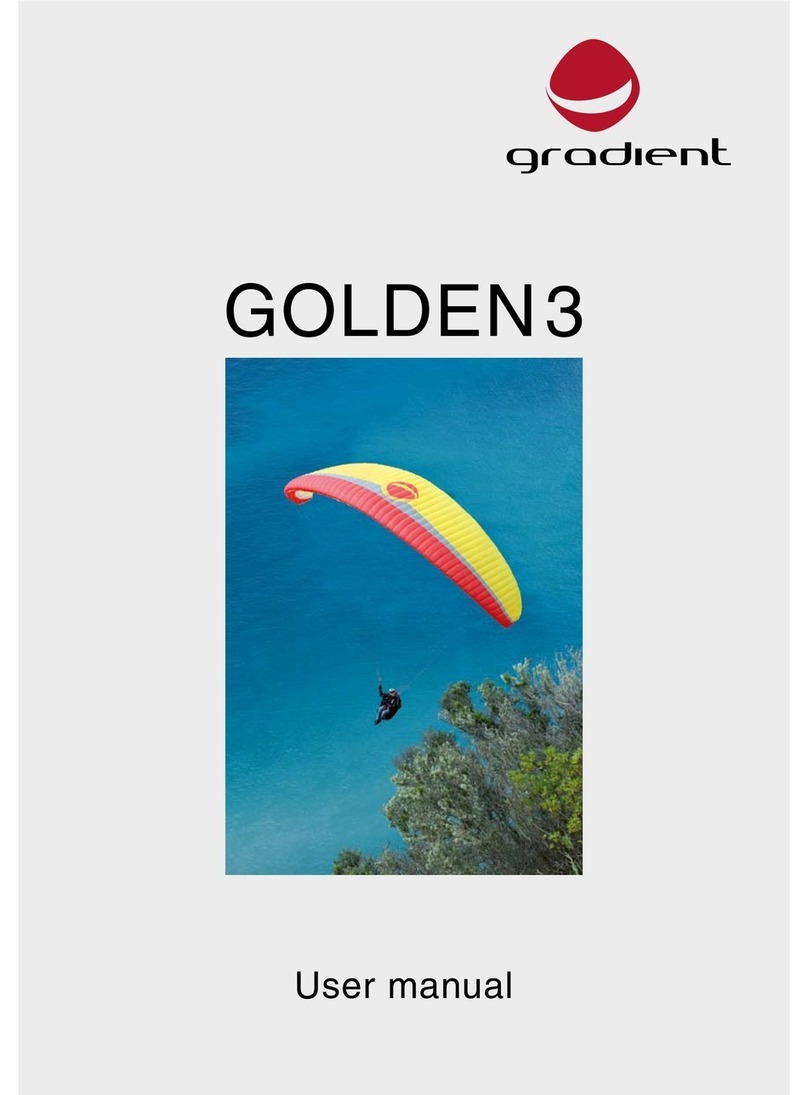
Gradient
Gradient GOLDEN3 User manual
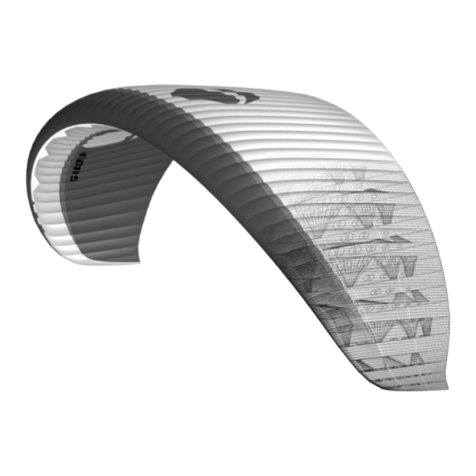
Gradient
Gradient Montana 3 User manual
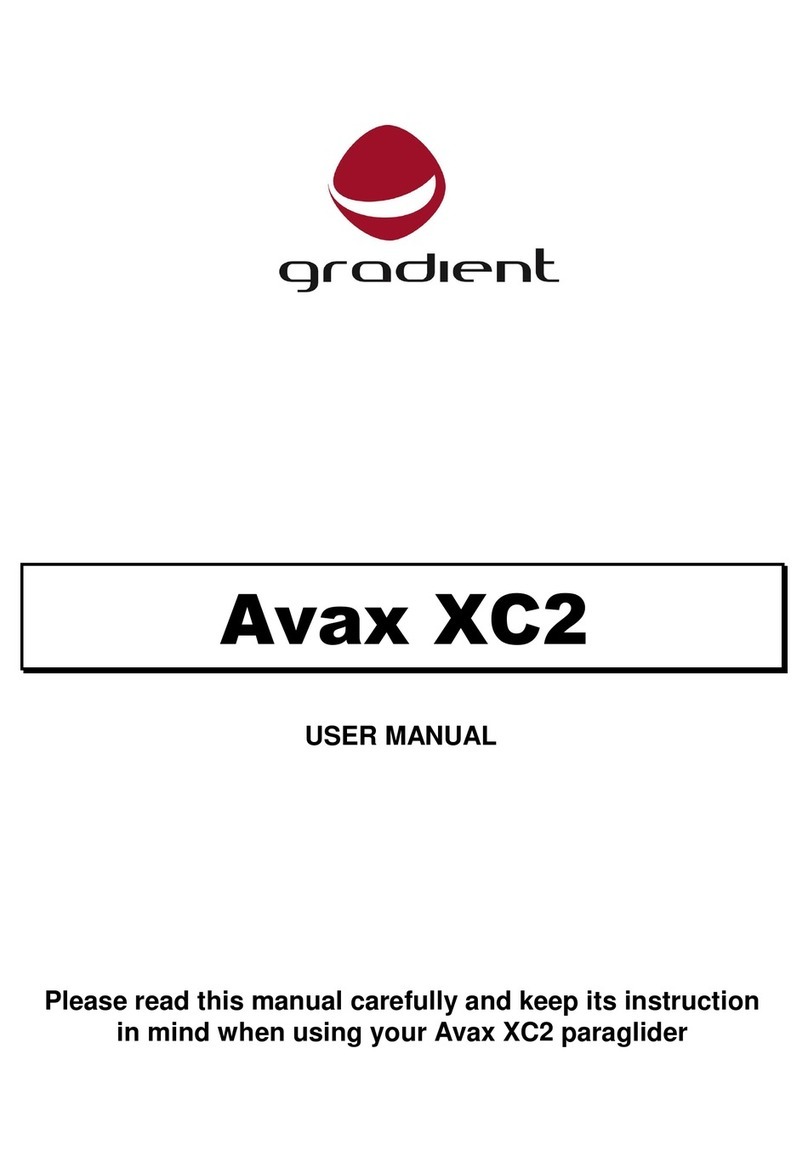
Gradient
Gradient Avax XC2 User manual
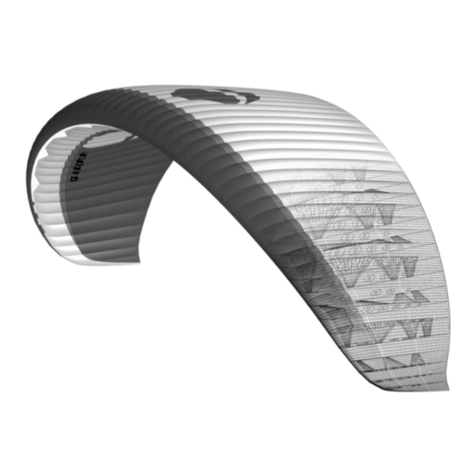
Gradient
Gradient Golden5 User manual
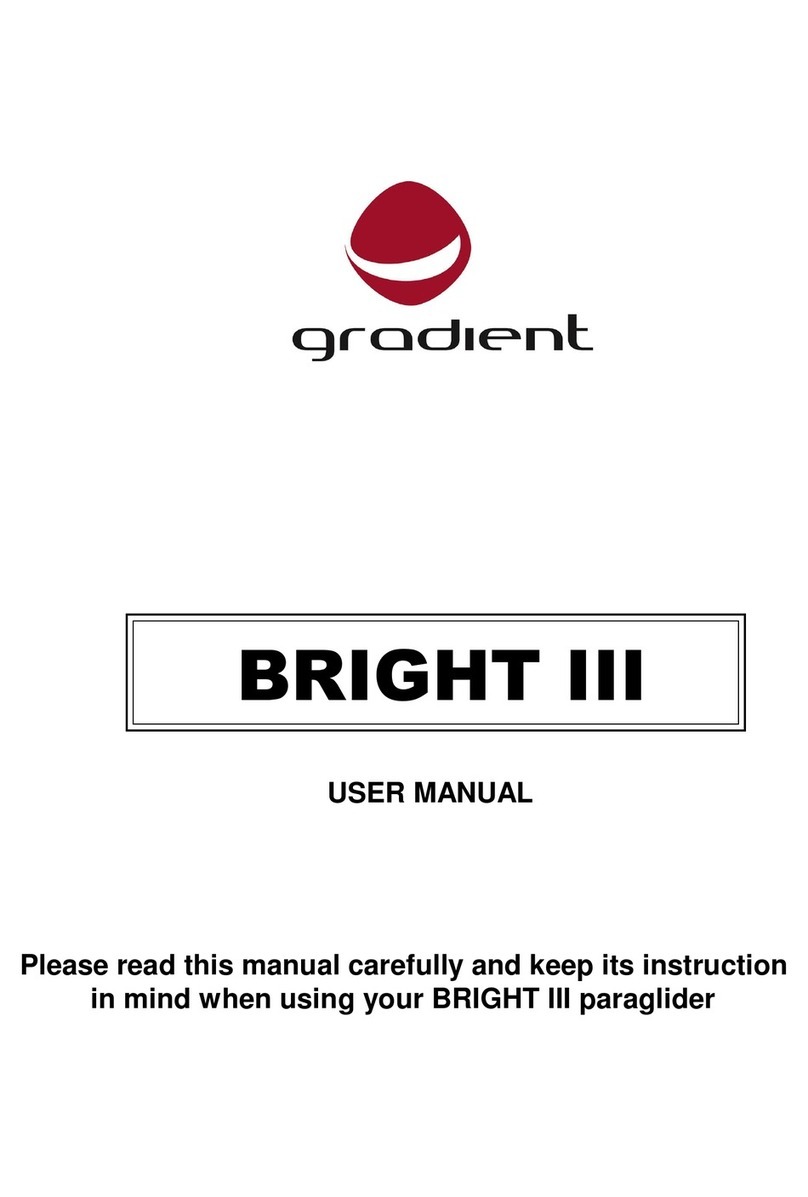
Gradient
Gradient BRIGHT III User manual
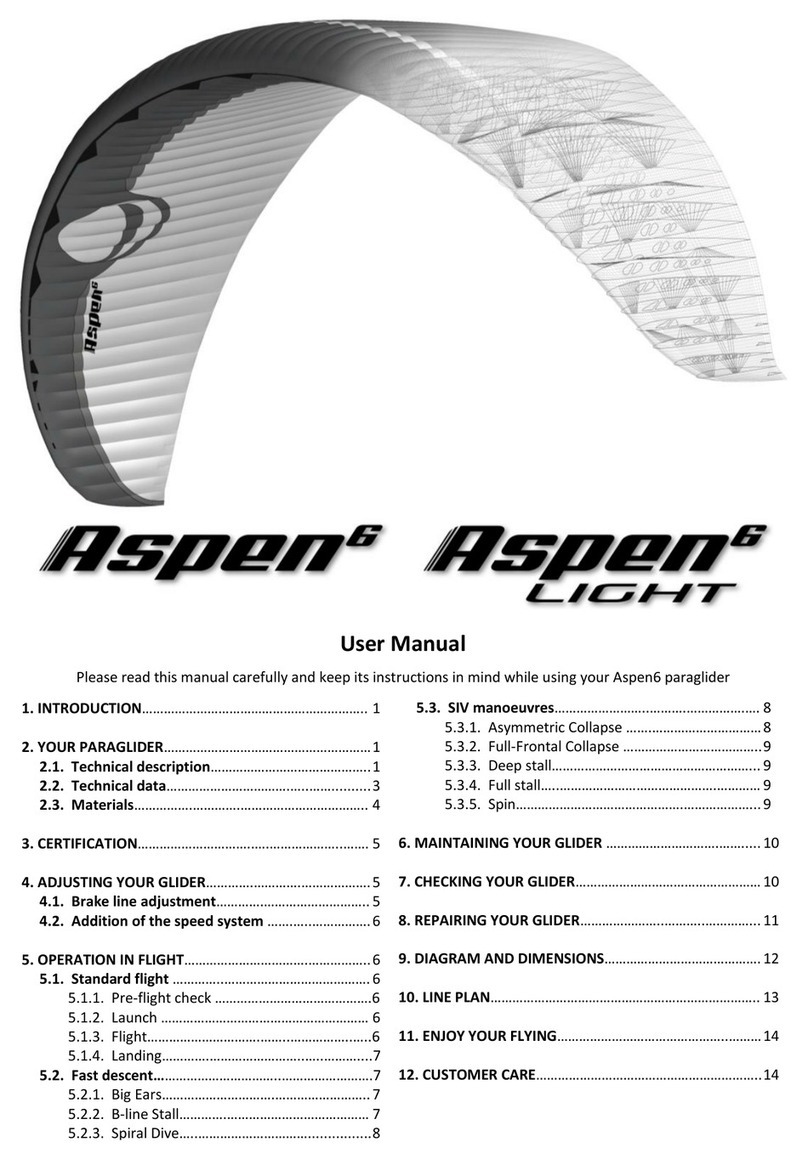
Gradient
Gradient Aspen 6 User manual
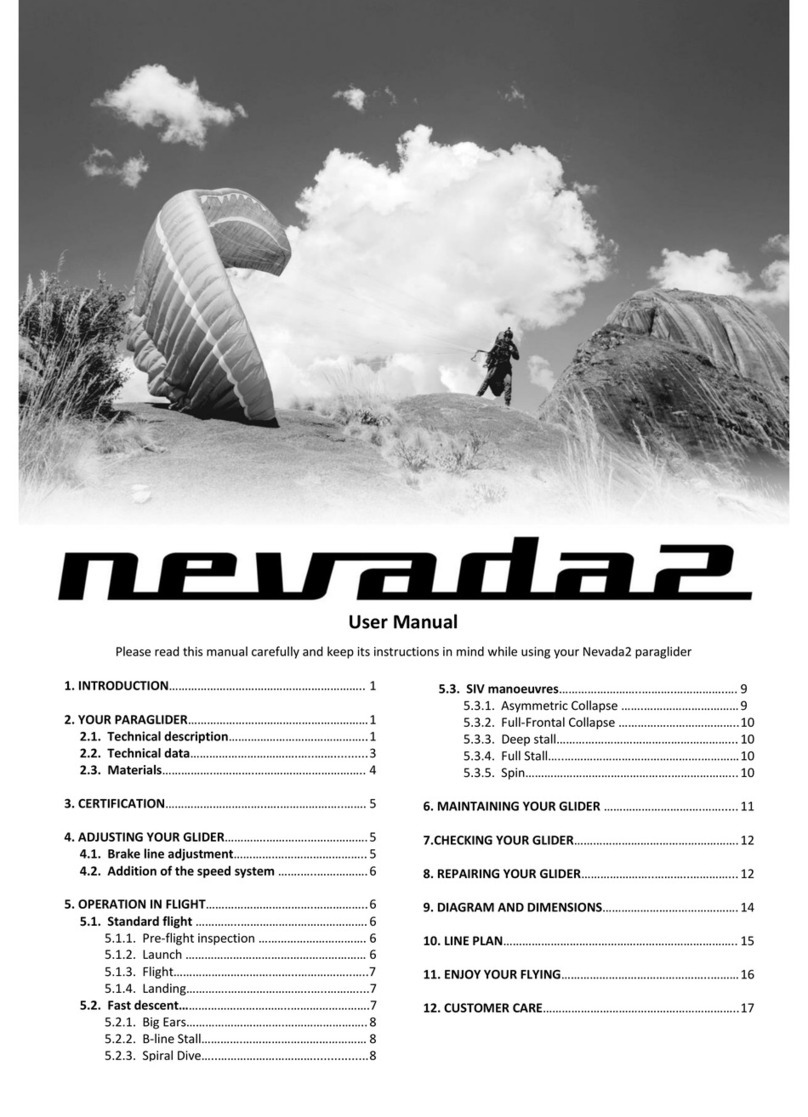
Gradient
Gradient Nevada2 User manual

Gradient
Gradient FREESTYLE 2 User manual
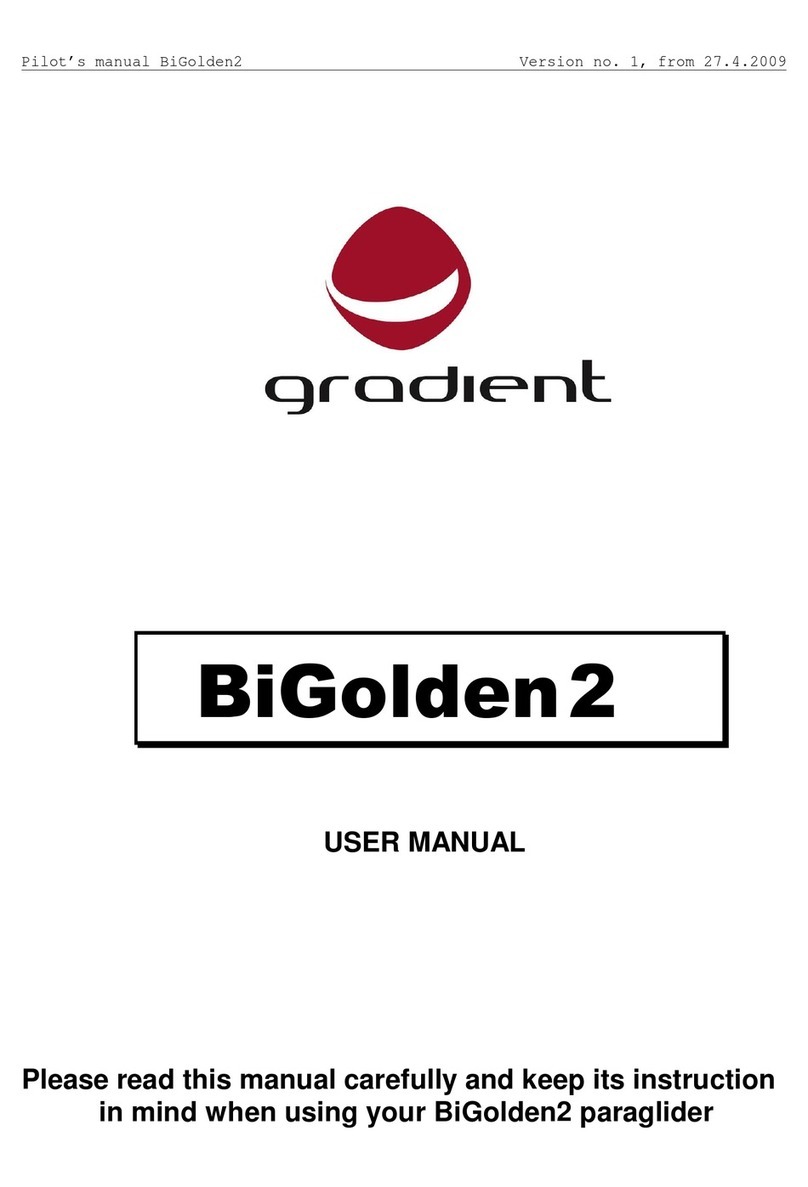
Gradient
Gradient BiGolden2 38 User manual
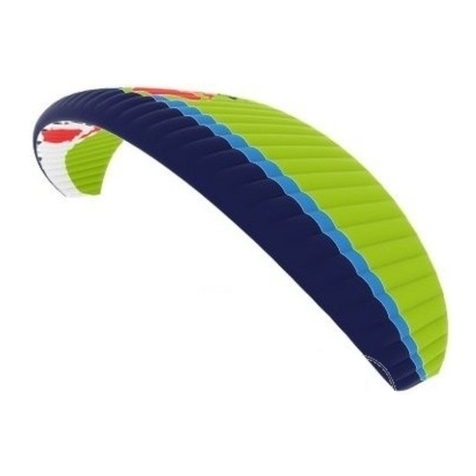
Gradient
Gradient Aspen5 User manual
Popular Aircraft manuals by other brands
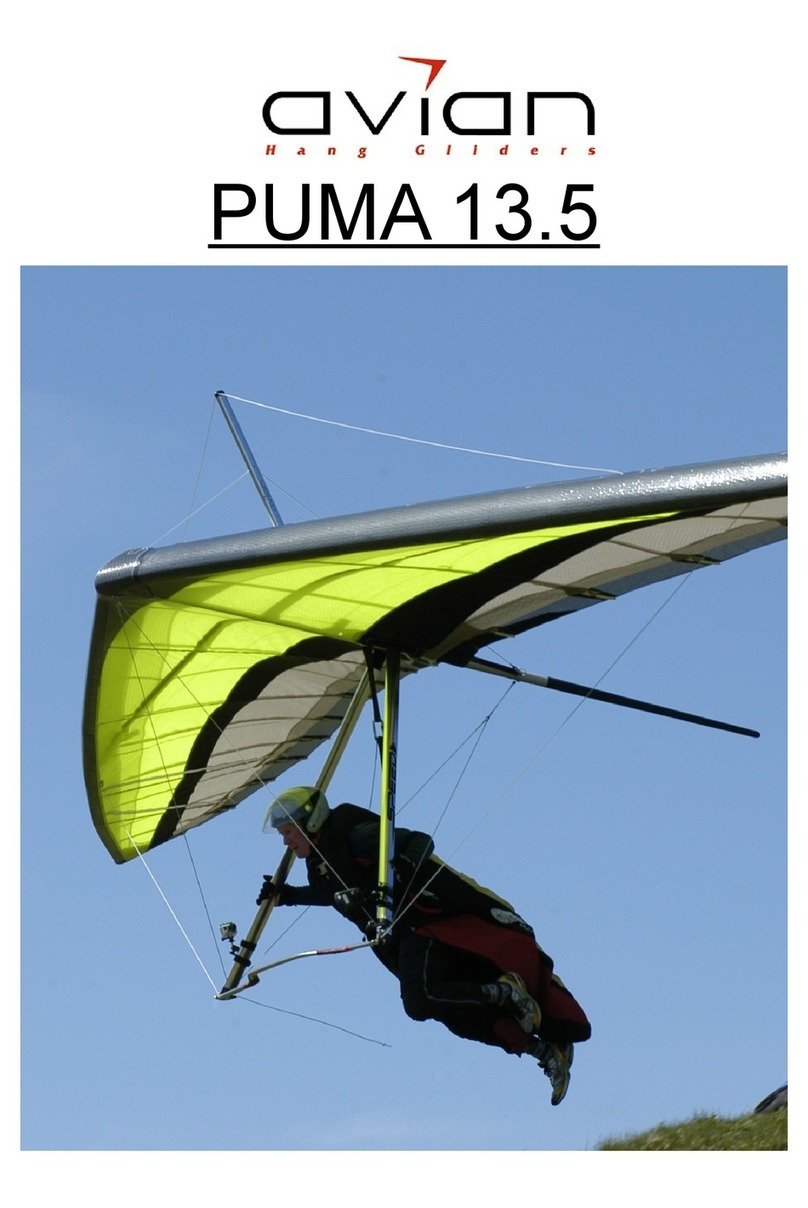
Avian
Avian PUMA 13.5 owner's manual
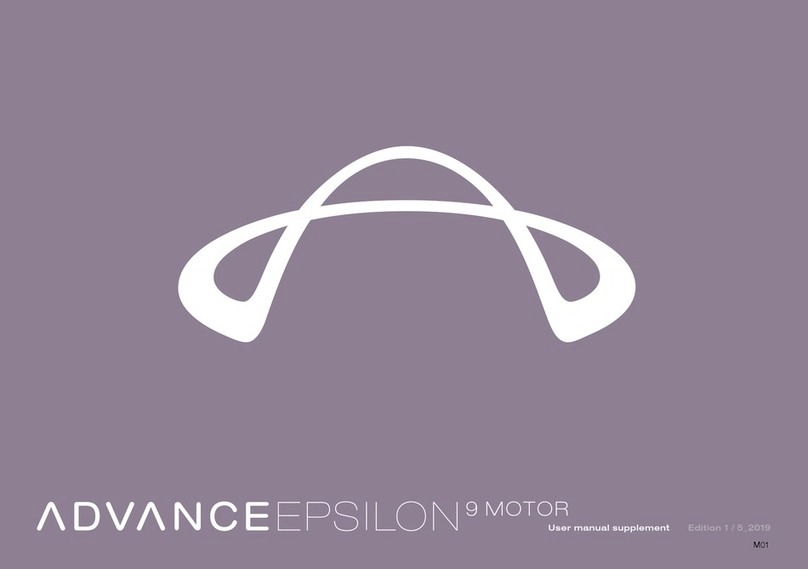
Advance acoustic
Advance acoustic Epsilon 9 Motor User's manual supplement
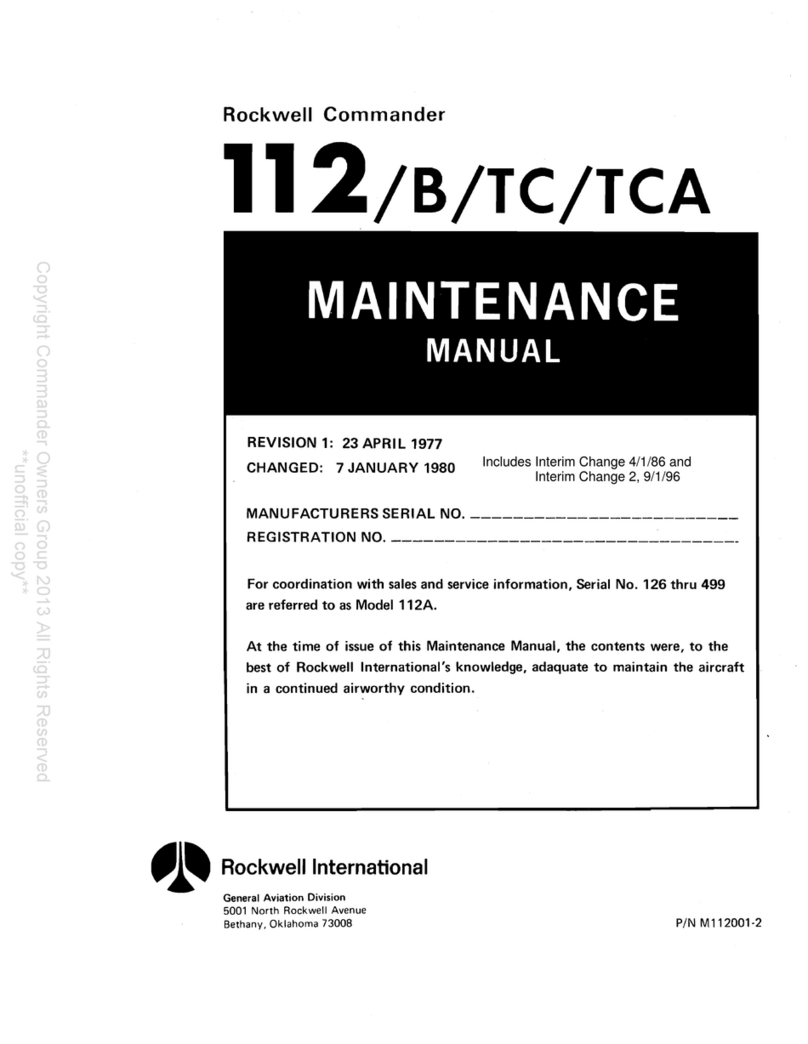
Rockwell
Rockwell Commander 112 Maintenance manual

Diamond
Diamond DA40 NG Quick reference handbook
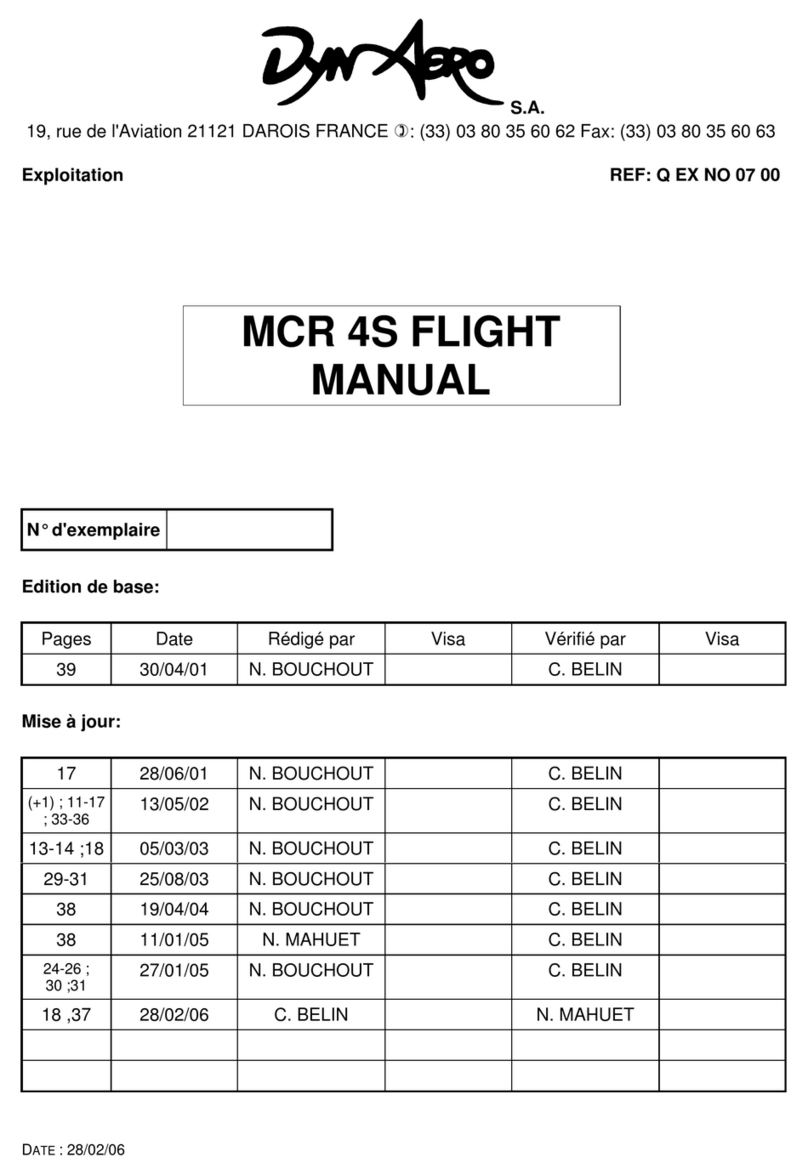
Dyn'Aéro
Dyn'Aéro MCR 4S Flight manual
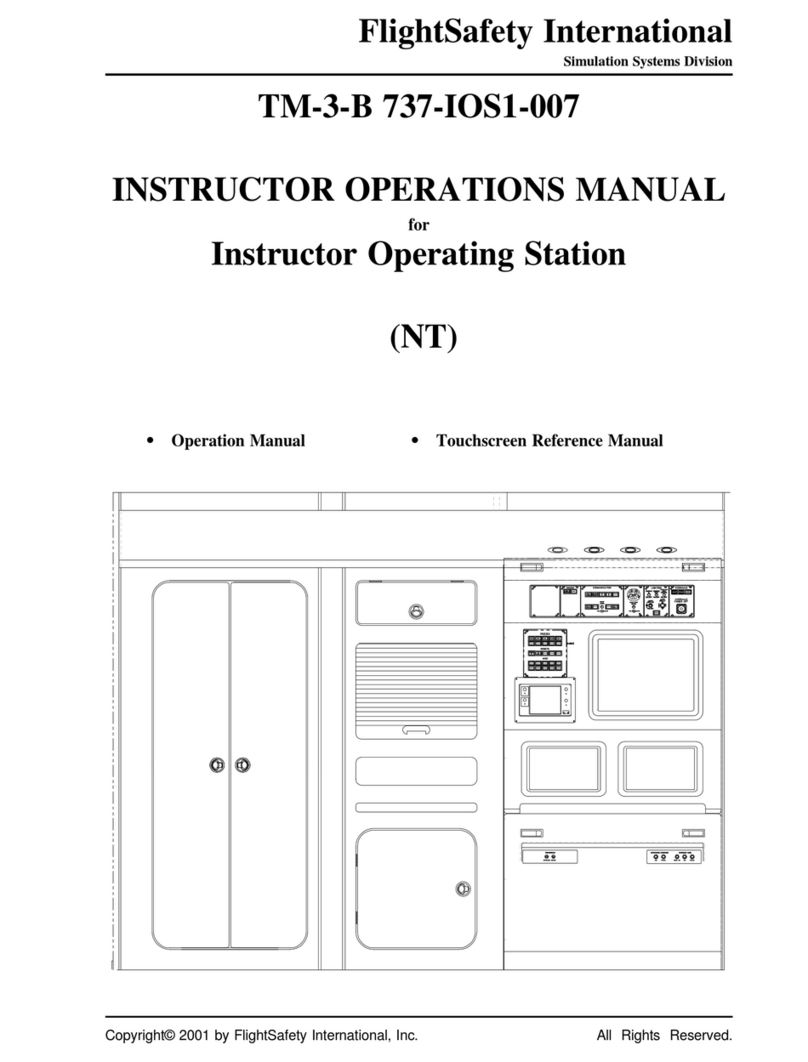
FlightSafety
FlightSafety TM-3-B instructor operations manual
